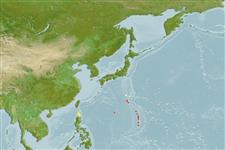Common names from other countries
Environment: milieu / climate zone / depth range / distribution range
Ecologia
marinhas associadas(os) a recifes; não migratória; intervalo de profundidade 1 - 56 m (Ref. 1602). Tropical; 28°N - 15°N
Western Pacific: known only from the Mariana and Ogasawara Islands; possibly a population southwest of Palau.
Tamanho / Peso / Idade
Maturity: Lm ? range ? - ? cm
Max length : 9.0 cm TL macho/indeterminado; (Ref. 9710); common length : 7.0 cm SL macho/indeterminado; (Ref. 37816)
Espinhos dorsais (total): 14; Raios dorsais moles (total): 16-18; Espinhos anais 3; Raios anais moles: 17 - 18. Its ground color is variable, ranging from almost red to light apricot. The barring can be reduced to a small patch behind the operculum, and in rare cases, be entirely absent. The blue trim on the soft dorsal and anal fins is absent or reduced in females and highly developed in males.
A common species (Ref. 9710) found singly or in small groups in exposed outer reef slopes and occasionally in clear lagoon reefs. Prefers areas of mixed dead and living corals with numerous shelter holes and passages (Ref. 1602). Feeds mainly on benthic algae. Forms harems of 3-7 individuals. Occasionally exported through the aquarium trade (Ref. 48391).
Life cycle and mating behavior
Maturidade | Reprodução | Desova | Ovos | Fecundidade | Larvas
Allen, G.R., 1985. Butterfly and angelfishes of the world. Vol. 2. 3rd edit. in English. Mergus Publishers, Melle, Germany. (Ref. 4858)
Categoria na Lista Vermelha da IUCN (Ref. 130435)
CITES (Ref. 128078)
Not Evaluated
Ameaça para o homem
Harmless
Utilização humana
Aquário: Espécies comerciais
Mais informação
Nomes comunsSinónimosMetabolismoPredadoresEcotoxicologiaReproduçãoMaturidadeDesovaFecundidadeOvosDesenvolvimento dos ovos
ReferênciasAquaculturaPerfil para aquaculturaEstirpesGenéticaElectrophoresesHereditariedadeDoençasProcessamentoMass conversion
ColaboradoresFotografiasStamps, Coins Misc.SonsCiguateraVelocidadeTipo de nataçãoÁrea branquialOutras referênciasCérebrosVisão
Ferramentas
Relatórios especiais
Descarregue XML
Fontes da internet
Estimates based on models
Phylogenetic diversity index (Ref.
82804): PD
50 = 0.5000 [Uniqueness, from 0.5 = low to 2.0 = high].
Bayesian length-weight: a=0.03090 (0.01359 - 0.07026), b=2.89 (2.70 - 3.08), in cm Total Length, based on LWR estimates for this (Sub)family-body shape (Ref.
93245).
Nível Trófico (Ref.
69278): 2.0 ±0.00 se; based on food items.
Resiliência (Ref.
120179): Elevada, tempo mínimo de duplicação da população menor que 15 meses (Preliminary K or Fecundity.).
Fishing Vulnerability (Ref.
59153): Low vulnerability (10 of 100).
